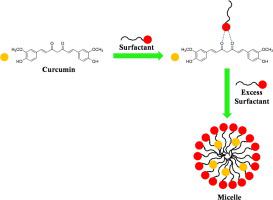Chemical Physics Letters ( IF 2.8 ) Pub Date : 2020-11-04 , DOI: 10.1016/j.cplett.2020.138144 Satyajit Mondal , Soumen Ghosh

|
Curcumin is a natural antioxidant and a polyphenol. The interaction of curcumin with different types of surfactants, (e.g., cationic gemini, anionic, nonionic and bile salt) in an aqueous medium has been studied spectrophotometrically and fluorimetrically in premicellar and post micellar concentration regions. Up to 0.095 mM concentration of cationic gemini surfactant (14-3-14), the absorbance value decreases and after that, increases. In the case of anionic SDMA and anionic sodium cholate (NaC), the absorbance value decreases up to 5.6 mM and 7.0 mM concentration respectively and then increases; after 11.0 mM concentration of SDMA and 17.0 mM concentration of NaC, the absorbance value becomes almost constant. For nonionic Mega 10, absorbance decreases initially and the peak is blue shifted to 371 nm. Then, with further addition of Mega 10, the absorbance value increases and the peak returns to its original position. After 7.4 mM concentration of Mega 10, the absorbance value becomes nearly constant. A fluorescence peak for Curcumin is observed at 537 nm. With increasing concentration of 14-4-14, initially, fluorescence intensity decreases up to 0.077 mM and then, fluorescence intensity increases and the spectra become gradually blue shifted to 501 nm. But for other surfactants used, fluorescence intensity increases with increasing concentration of surfactant and the spectra become gradually blue shifted and after the cmc, the intensity becomes constant. For 14-5-14, initially, anisotropy value increases and then decreases and after the cmc, this value again increases. In the case of SDMA, this value decreases with increasing concentration of SDMA up to 5.6 mM and then increases, after 13.5 mM, this becomes almost constant. For 212, no significant change of this value is observed. In the case of NaC, anisotropy value increases with increasing concentration of NaC and after 16.0 mM, it is almost constant. In the case of Mega 10, it decreases with increasing concentration of surfactant and above the cmc, becomes almost zero. In the premicellar region, curcumin forms complex with surfactant molecules and in the post micellar region, it is incorporated into the hydrophobic core of the micelle. The change in the intensity and wavelength of typical peaks in the absorption and the fluorescence spectra of curcumin shows a considerably different interaction behavior of surfactant molecules with curcumin.
中文翻译:

姜黄素与单链和双子表面活性剂相互作用的光谱研究
姜黄素是天然的抗氧化剂和多酚。姜黄素与不同类型的表面活性剂(例如,阳离子双子,阴离子,非离子和胆汁盐)在水性介质中的相互作用已通过分光光度法和荧光法在胶束前和胶束后浓度区进行了研究。浓度高达0.095 mM的阳离子双子表面活性剂(14-3-14),吸光度值降低,此后增加。对于阴离子SDMA和阴离子胆酸钠(NaC),吸光度值分别降低至5.6 mM和7.0 mM浓度,然后增加;在浓度为11.0 mM的SDMA和浓度为17.0 mM的NaC之后,吸光度值几乎保持恒定。对于非离子Mega 10,吸光度最初会降低,并且峰蓝色偏移至371 nm。然后,进一步添加Mega 10,吸光度值增加,峰回到其原始位置。在浓度为7.4 mM的Mega 10之后,吸光度值几乎恒定。在537 nm处观察到姜黄素的荧光峰。随着浓度的增加14-4-14,最初,荧光强度降低到0.077 mM,然后,荧光强度增加,并且光谱逐渐变为蓝色,移至501 nm。但是对于使用的其他表面活性剂,荧光强度随表面活性剂浓度的增加而增加,并且光谱逐渐变为蓝移,并且在cmc之后,强度变为恒定。对于14-5-14,各向异性值首先增大,然后减小,然后在cmc之后,该值再次增大。对于SDMA,此值会随着SDMA浓度的增加而降低,直至5.6 mM,然后增加,在13.5 mM之后,这几乎保持不变。对于212,没有观察到该值的显着变化。在NaC的情况下,各向异性值随NaC浓度的增加而增加,并且在16.0 mM之后,各向异性值几乎恒定。在Mega 10的情况下,它随着表面活性剂浓度的增加而降低,并且在cmc之上几乎变为零。在胶束前区,姜黄素与表面活性剂分子形成复合物,在胶束后区,姜黄素被掺入胶束的疏水核中。姜黄素的吸收峰和荧光光谱中典型峰的强度和波长的变化表明表面活性剂分子与姜黄素的相互作用行为有很大不同。各向异性值随NaC浓度的增加而增加,在16.0 mM之后,各向异性值几乎恒定。在Mega 10的情况下,它随着表面活性剂浓度的增加而降低,并且在cmc之上几乎变为零。在胶束前区,姜黄素与表面活性剂分子形成复合物,在胶束后区,姜黄素被掺入胶束的疏水核中。姜黄素的吸收峰和荧光光谱中典型峰的强度和波长的变化表明表面活性剂分子与姜黄素的相互作用行为有很大不同。各向异性值随NaC浓度的增加而增加,在16.0 mM之后,各向异性值几乎恒定。在Mega 10的情况下,它随着表面活性剂浓度的增加而降低,并且在cmc之上几乎变为零。在胶束前区,姜黄素与表面活性剂分子形成复合物,在胶束后区,姜黄素被掺入胶束的疏水核中。姜黄素的吸收峰和荧光光谱中典型峰的强度和波长的变化表明表面活性剂分子与姜黄素的相互作用行为有很大不同。姜黄素与表面活性剂分子形成复合物,并在胶束后区域,并入胶束的疏水核中。姜黄素的吸收峰和荧光光谱中典型峰的强度和波长的变化表明表面活性剂分子与姜黄素的相互作用行为有很大不同。姜黄素与表面活性剂分子形成复合物,并在胶束后区域中被引入胶束的疏水核中。姜黄素的吸收峰和荧光光谱中典型峰的强度和波长的变化表明表面活性剂分子与姜黄素的相互作用行为有很大不同。



























 京公网安备 11010802027423号
京公网安备 11010802027423号